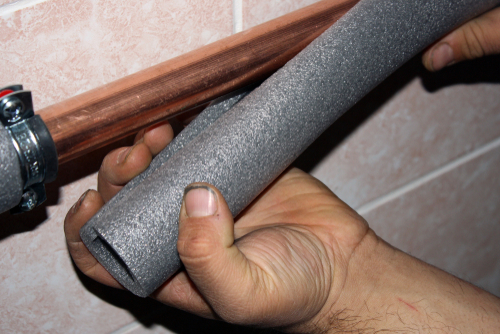July 31, 2024
How to Prevent Sweating Pipes [Video]
Seeing your home plumbing pipes covered in droplets of water can be a puzzling and concerning sight. This phenomenon, commonly referred to as “sweating pipes,” can easily be mistaken for a plumbing leak. In most instances, it’s just a natural occurrence caused by condensation.
As your local home service experts, we want to make sure you understand why pipes sweat, the factors that contribute to it, why it could be a problem and what you can do to manage this issue in your home. Watch our pipe sweating video below and then read on to learn more.
Types of Pipes That Sweat and Why
Understanding which types of pipes are most likely to sweat can help you take targeted measures to prevent condensation. Here’s a closer look at the types of pipes that typically experience sweating and the reasons behind it.
Cold Water Pipes
Reason for Sweating: Cold water pipes are the most common culprits when it comes to sweating. As cold water flows through these pipes, the temperature of the pipe surface drops below the dew point of the surrounding air. When warm, humid air comes into contact with these cold surfaces, condensation forms.
Examples:
- Copper Pipes: Copper is a good conductor of temperature, which means it quickly adapts to the temperature of the water inside. This makes copper pipes prone to sweating in humid environments.
- PVC Pipes: While PVC pipes don’t conduct temperature as effectively as copper, they can still sweat under the right conditions, especially if the ambient humidity is high.
Pipes in Humid Areas
Reason for Sweating: Pipes located in humid areas such as basements, crawl spaces, and attics are more likely to sweat. The high moisture content in the air in these spaces increases the chances of condensation forming on the pipe surfaces.
Examples:
- Basement Pipes: Basements are often cooler and more humid than other parts of the home, making them a prime location for pipe sweating.
- Crawl Space Pipes: Crawl spaces typically have limited ventilation, leading to high humidity levels that can cause pipes to sweat.
Uninsulated Pipes
Reason for Sweating: Uninsulated pipes are more exposed to the surrounding air and its moisture. Without insulation, the cold surface of the pipe is in direct contact with warm, humid air, increasing the likelihood of pipe condensation.
Examples:
- Metal Pipes: Metal pipes, including copper, galvanized steel and iron, are especially prone to sweating due to their high thermal conductivity and lack of insulation.
- Older Plumbing Systems: Older homes may have plumbing systems without proper insulation, making these pipes more susceptible to sweating.
Pipes with Continuous Cold Water Flow
Reason for Sweating: Pipes that have a constant flow of cold water, either from frequent use or leaks, stay cold for longer periods. This prolonged exposure to cold temperatures makes them more likely to condense moisture from the air.
Examples:
- Main Water Supply Lines: The main supply lines bringing cold water into your home are often the first to sweat due to their continuous exposure to cold water.
- Pipes Connected to Frequently Used Fixtures: Pipes connected to fixtures like showers, toilets, and washing machines, which are used frequently, are also prone to sweating.
How to Prevent Your Pipes from Sweating

There are several steps you can take to reduce or eliminate pipe sweating in your home:
Insulate Your Pipes
Not only is pipe insulation a good way to prevent your pipes from freezing in the winter, it is also one of the most effective ways to prevent condensation year-round. Insulating materials, such as foam sleeves or wraps, keep the cold surface of the pipes from coming into direct contact with warm, humid air.
Improve Ventilation
Increasing airflow around your pipes can help reduce humidity levels. Use exhaust fans, dehumidifiers, install vents or simply open windows to allow moist air to escape.
Fix Leaks
Repair any leaky faucets or appliances to prevent continuous cold water flow through your pipes. This will help maintain a more consistent temperature and reduce the risk of sweating.
Maintain Proper Temperature
Keep the ambient temperature in areas with exposed pipes as consistent as possible. Avoid drastic temperature changes that can increase the likelihood of condensation.
Why it’s Important to Stop Pipe Sweating
While pipe sweating itself is not harmful, the resulting moisture can lead to several issues in your home. While their short-term impact may be minimal, over the long-term, these can prove unhealthy and expensive:
Water Damage
Persistent condensation can cause damage to walls, floors, and ceilings, especially if it goes unnoticed. Over time, this moisture can lead to mold growth and wood rot.
Mold and Mildew

Mold and mildew thrive in damp environments. Sweating pipes can create the perfect conditions for mold to grow, which can pose health risks to you and your family.
Corrosion
Prolonged exposure to moisture can cause metal pipes to corrode, leading to leaks and the need for costly repairs or replacements.
Your Colorado Pipe Experts
Sweating pipes are a common issue in many homes. By understanding the causes and taking preventative measures can help you manage and minimize the problem. If you need assistance with pipe insulation or if you need pipe repair or replacement, schedule with the local plumbing experts at Applewood. We know how to stop condensation and keep Colorado homes healthy and safe.


